Breeds of chickens with furry paws
Breeding of domestic chickens is common throughout the world. For several decades now, breeders have been breeding breeds that differ in certain productivity characteristics or appearance. Some of the most popular for home keeping are shaggy-footed chickens.
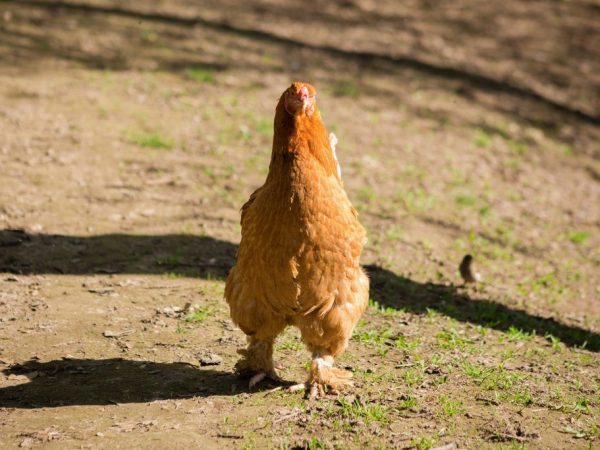
Chickens with furry paws
What caused the demand for such birds? The fact is that some breeders do not strive to achieve high rates of egg production or growth of chickens. Their goal is to add variety to their household, and chickens with furry paws are so beautiful that from the first days they will be able to decorate the poultry yard.
Story
More than 800 are known today chicken breeds, which are representatives of certain areas of productivity. Some are distinguished by egg production, some by active weight gain. Decorative representatives of birds are no less popular. Breeding of the latter bears fruit, but their volume is several times less than that of productive birds.
It is impossible to call hairy chickens rare. The fact is that the first attempts of breeders to breed such unusual breeds were recorded in the 19th century.
Despite the beginning of the vigorous activity of breeders, the breed that became the inspiration for them, many believe Silk Chinese Chicken... Even Aristotle in his writings wrote about birds, which were covered with cat hair instead of feathers. The historically confirmed fact is dated to the middle of the 4th century BC.
In total, farmers breed more than 100 exotic bird species. Those that are endowed with furry paws make up a third of this number. A domestic farmer should know that only a few breeds are able to survive in our climatic conditions.
Ornamental chicken breeds
Shaggy chickens, with their unusual appearance, attract the attention of many people. Not only experienced breeders are interested in them, but also ordinary animal lovers. Today in the domestic market you can find such varieties of chicken breeds with shaggy legs:
Each breed has its own external features that distinguish it from the rest of the birds. Such chickens, despite their decorative affiliation, are capable of giving the breeder, with proper care, average egg production. So, the Brama breed gives up to 120 eggs per year (each egg weighs 55-60 g). And Ushanka - up to 180 eggs (58-65 g each). That is, the farmer who breeds such chickens receives not only decoration, but also a valuable productive bird.
High performance rates among furry-footed chickens can also affect live weight. At home, with proper care, the Faverol breed can be a real boon for humans. The live weight of such birds often reaches 5 kg. Cochinquin has the same indicators.
Cochinhin
Cochinhin is a breed of chickens with furry paws, bred on the territory of Indochina in the 9th century. Such a bird is one of the founders of modern breeding.Having entered the territory of Russia in the 19th century, individuals of the Cochinchin became one of the most demanded in domestic farms. Such chickens, in suitable conditions, can be distinguished by good endurance, as well as productivity in winter. Photos of layers of this breed have repeatedly adorned the most popular farming magazines.
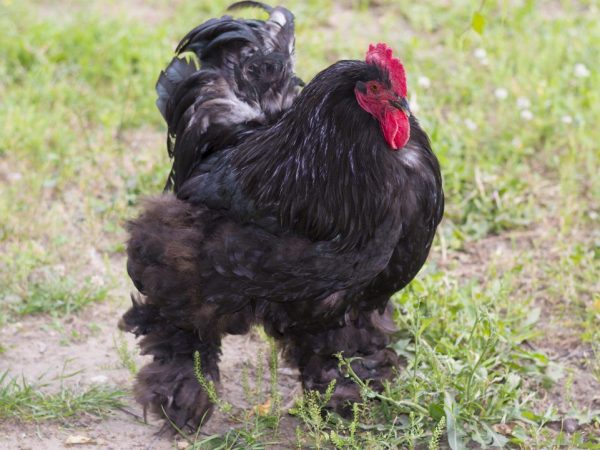
Cochinchin chicken breed
Before acquiring a livestock from Konhankhins, you need to find out about the advantages and disadvantages of this breed. In addition to the beautiful appearance, farmers are attracted by:
- unpretentiousness in nutrition;
- the possibility of obtaining eggs in winter;
- large weight of carcasses;
- no need for long walks.
This breed also has disadvantages. The most important of these is the high price per head in the market. In addition, when bred at home, these birds quickly lose their breed characteristics. Also, the Cohenkhin have a slow maturation of chickens.
Such chickens with unusual legs are massive, therefore they belong to meat breeds. The head is small, the eyes are protruding, and a scarlet rough tuft flaunts on the head.
The plumage can have different colors. It depends on what kind of Cochinchin itself. There are black, white and two-colored and even brown colors of these birds. The most exotic species is the striped type of birds. This breed has a black and blue coloring, it is because of it that these birds are so popular.
Siberian Beetles
Siberian Uplands were bred in Russia. There is no exact historical confirmation of when exactly this breed was discovered. Due to the wars, revolution and famine in which the country was immersed in the first half of the 20th century, representatives of these birds were completely destroyed.
Several decades ago, breeders were able to find several birds with shaggy legs that remained in nature and resumed their population. Now the Uplands breed has become one of the most popular in Russia, partly because of its unusual appearance. In the photo, Siberian Beetles look more like a wild bird than a farm bird.
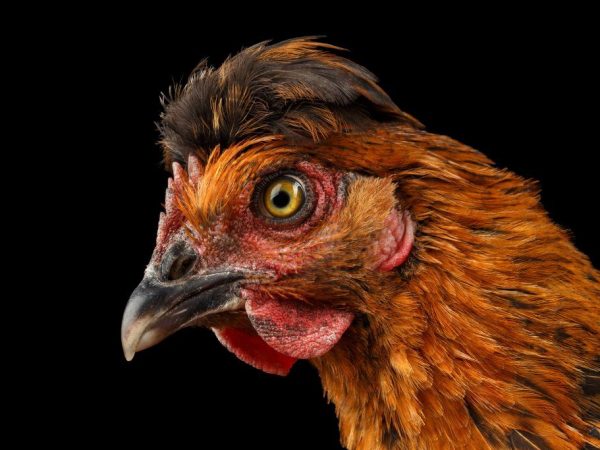
Breed of chickens Siberian Upland
The benefits of the restored Upland population are evidence that birds are in demand in the market. Every breeder who has bought a livestock of "Siberian" birds can be content with:
- egg productivity (up to 180 pieces per year);
- average carcass weight (2.5-3.5 kg);
- high fertility of eggs;
- ease of caring for birds.
The hen of this breed has a long, bushy beard (males also have it). On the head, the crest is small, so it is often not visible under the tuft. The shaggy cover is a protection from the harsh domestic frosts. Its color is black with a noticeable sheen.
The fact that the birds on the market are called Siberian Uplands does not indicate their exact identity to the extinct representatives of the birds. In comparison with the declared description of the beginning of the 20th century, these chickens are endowed with a pink-shaped crest. Modern Siberians are horn-shaped. There are also differences with the paws. The current breed is endowed with the plumage of "spruce paws", while the old birds did not have such a feature.
Brama
Brahma is an American chicken with furry legs, bred in the second half of the 19th century.
It became popular after the rulers of the United States presented the specimen to the Queen of England. Already at that time, farmers noticed an unusual appearance of such individuals. The color of the birds is light, often a partridge shade predominates (the full name of the breed is Brahma Partridge). The body is massive, the head is small. The plumage itself tends to grow. In adulthood, these birds become like a large soft toy and when even the weakest wind blows, they become like a fan.
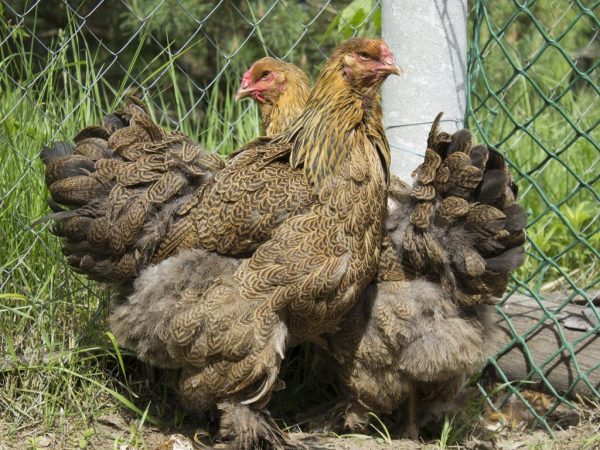
Breed of chickens Brahma
Such birds with furry legs are popular all over the world. They are also found in domestic markets. They have many advantages. Some of them:
- good immunity and endurance;
- unpretentious content;
- average productivity indicators for meat and eggs.
Chickens with legs covered with thick plumage can be attributed to meat and egg breeds... Egg production - up to 140 pieces per year. Eggs are white with dark patches on the shell. Carcass weight - 3.5-5 kg. The net yield of this product is 50-52%. The meat itself is tasty, but there is a slight toughness that is not characteristic of most domestic birds.
The color of the feathers of these birds is different. Broods of the Partridge breed have a white color with black spots on the body. Brown and red feathers are sometimes found. Such birds are similar to pheasants in the structure of their body, as well as a tuft that stands out on the head.
Features of other decorative birds
Pavlovsk chickens are one of the most beautiful decorative birds.
They were bred in the 18th century in Russia in the village of Pavlovo (hence the name). The main task of breeders of that time was associated with obtaining strong individuals that calmly endure frosts. Experts have coped with the task at all 5. Since that time, the population of these birds has grown to millions and does not decline until today.
The appearance of Pavlovsk chickens is impressive. They have bright, dense plumage, the color of which can be different. Most often, individuals with orange-black plumage are found.
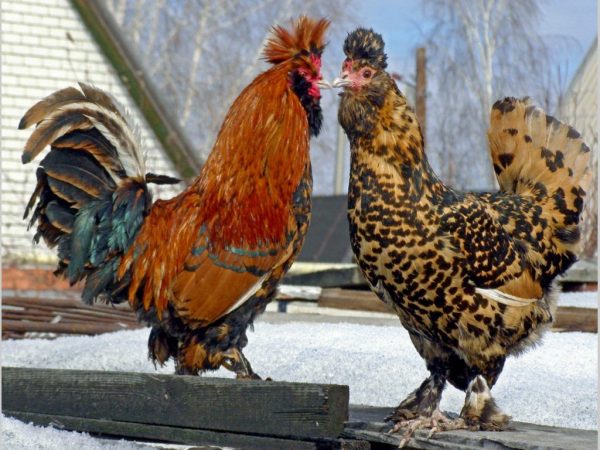
Chickens of the Pavlovsk breed
It is the color design that determines the belonging of the bird to one of the 2 varieties of Pokrovtsy. The silvery appearance is distinguished by the appearance of a tuft on the head: it is flattened from the sides. The color of the feathers of such representatives is white, sometimes black. The golden look has a coarse crest and a standard color scheme. In the general photo, these features of the appearance of the rocks immediately catch the eye.
In addition to their unusual appearance, the representatives of this breed do not carry any advantages for the breeder. There are many disadvantages. Pokrovtsy are picky in nutrition, care and maintenance, have low productivity. It is advisable to keep them for aesthetic pleasure only.
There are also newer, domestic decorative species of birds. One of them is Ushanka, obtained by crossing the Pokrovsky and Oryol chickens... The plumage of its representatives is brown, and the tail is black. Due to its high productivity, Ushanka is popular with domestic farmers. One female gives up to 170 eggs per year with a weight of 2.5 kg. Roosters are slightly larger - they can weigh up to 3 kg. There are very few disadvantages of such birds. The most important of these is the difficulty of keeping in high humidity conditions. Such climatic conditions often cause diseases.


